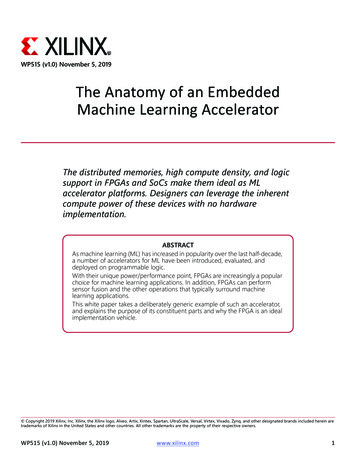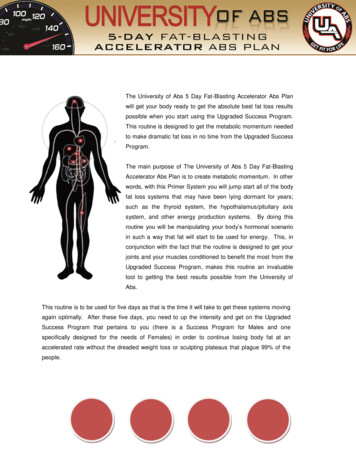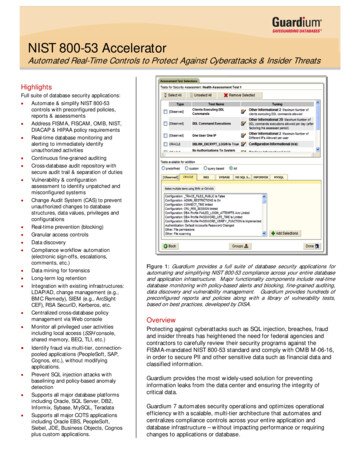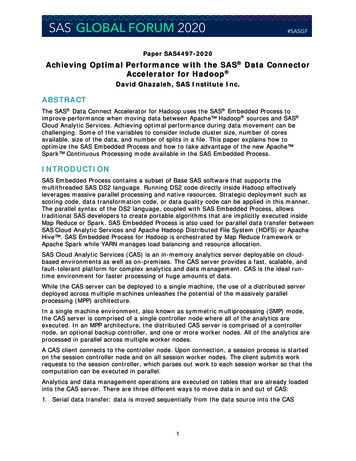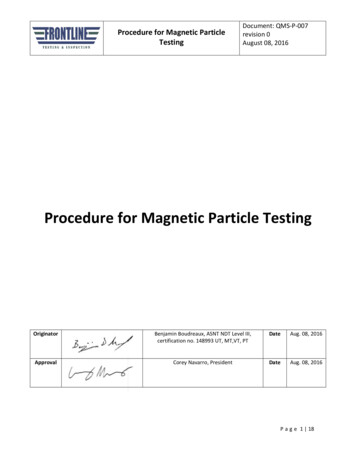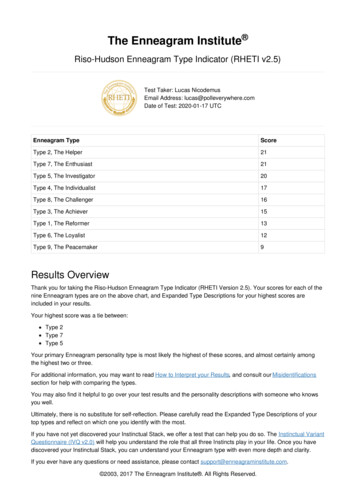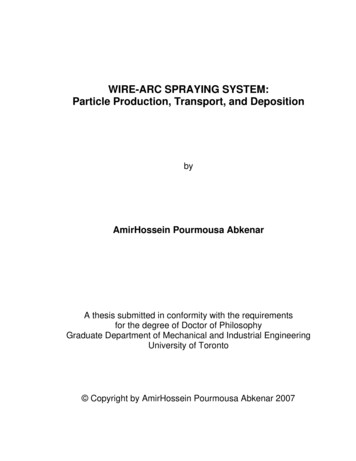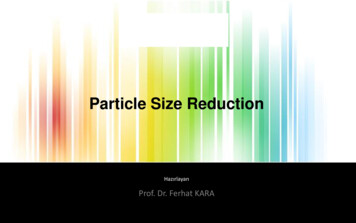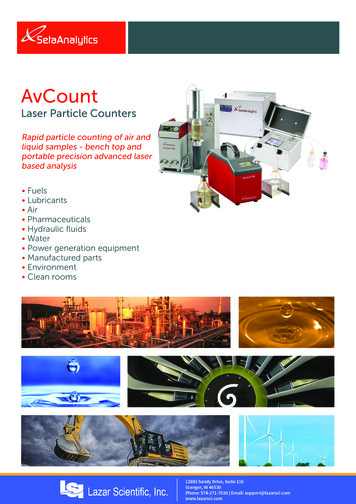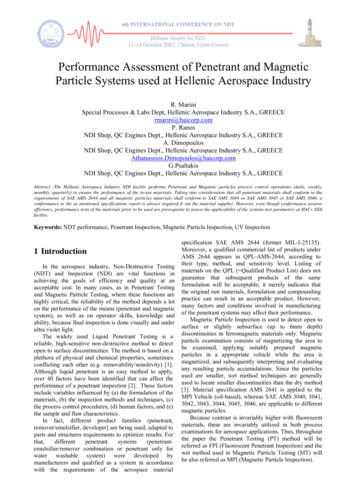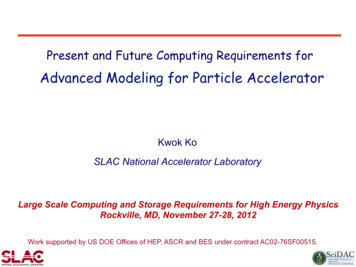
Transcription
Present and Future Computing Requirements forAdvanced Modeling for Particle AcceleratorKwok KoSLAC National Accelerator LaboratoryLarge Scale Computing and Storage Requirements for High Energy PhysicsRockville, MD, November 27-28, 2012Work supported by US DOE Offices of HEP, ASCR and BES under contract AC02-76SF00515.
1. Advanced Modeling for Particle Accelerators (AMPA)NERSC Repositories: m349Principal Investigator: K. KoSenior Investigators: SLAC - L. Ge, Z. Li, C. Ng, L. Xiao,FNAL - A. Lunin,Jlab - H. Wang,BNL - S. Belomestnykh,ANL - A. NassiriLBNL - E. NgCornell - M. LiepeODU - J. DelayenMuplus - F. Marhauser
1. Advanced Simulation Code at SLACAgendaHigh EnergyPhysics AdvisoryPanelWashington, D.C.March 12-13, 2012Report from DOE/HEPJ. Siegrist
1. AMPA Scientific Objectives Under DOE’s HPC programs and SLAC supportAccelerator Grand Challenge 1998–2001,SciDAC1- Accelerator Science and Technology (AST) 2001-07,SciDAC2 - Community Petascale Project for Accelerator Science and Simulation (ComPASS)2007-12,SLAC has built a parallel computing capability, ACE3P, for high-fidelity and highaccuracy accelerator modeling and simulation. ACE3P (Advanced Computational Electromagnetics 3P) is a suite of 3D codes built tobe scalable to utilize DOE’s HPC facilities such as NERSC which enables acceleratordesigners and RF engineers to model and simulate components and systems on a scale,complexity and speed not previously possible. ACE3P has been benchmarked against measurements and successfully applied to abroad spectrum of applications in accelerator science, accelerator development andfacilities within the Office of Science and beyond. AMPA presently focuses on meeting SLAC and SciDAC project goals as well asproviding computational support to the ACE3P user community. By 2017 AMPA expects to establish the multi-physics capabilities in ACE3P to benefitboth the normal conducting and SRF cavity/cryomodule R&D efforts and develop an endto-end PIC tool for RF source modeling to further broaden the user base.
1. Near Term Projects for SLAC and SciDACHEPProject X linac design - Higher-order-modes (HOM) in the presence of cavity imperfections and misalignments.Estimated CPU hours are 250k.Dielectric laser acceleration and structure wakefields – Power coupling /wakefield for optical photonic bandgapfibers and wakefield acceleration in beam excitation experiment for FACET. Estimated CPU hours are 200k.LHC crab cavity design - Optimize the shape of the compact 400 MHz dipole mode cavity. Estimated CPUhours are 100k.MAP cavity design - Optimize the 805-MHz cavity for the MuCool program. Estimated CPU hours are 100k.High-gradient cavity design - Radio frequency (RF) breakdown and associated dark current issues. EstimatedCPU hours are 50k.BESANL SPX crab cavity - Trapped modes and muli-physics analysis in cryomodule. Estimated CPU hours are200k.PEPX-FEL simulation - 1.5GHz SRF cavity design. Estimated CPU hours are 200k.NGLS/LCLS2 energy chirper – Wakefield calculations with possible application to LCLS2. Estimated CPU hoursare 50k.SRF gun design - Temperature calculation and thermo-elastic computation of stress and displacement .Estimated CPU hours are 50kTOTAL – 1.2 M CPU hoursPage 5
1. Anticipated Projects by 2017 for SLACHEPProject X linac design - Cryomodule simulation. Increase to 300k CPU hrs.High-gradient cavity design - Simulation of dark current transient effects. Increase to 200k CPU hrsDielectric laser acceleration and structure wakefields – Continuation. 200k CPU hrs.LHC crab cavity design - Continuation. 100k CPU hrs.MAP cavity design - Continuation. 100k CPU hrs.BESPEPX-FEL simulation - Multi-physics calculation. Increase to 250k CPU hrsANL SPX crab cavity - Continuation. 200k CPU hrs.NGLS – SRF crab cavity design. Increase to 100k CPU hrs.SRF gun design - Evaluate alternate designs Increase to 100k CPU hrs.HEP, NP, BESSRF multi-physics modeling - Develop and apply integrated capability for EM, thermal and mechanicalsimulation of SRF cavities and cryomodules that include the CW and pulsed linacs of Project X (HEP), eRHICERL linac (NP), & APS upgrade with SPX deflecting cavity (BES). Increase to 600K CPU hrsRF source modeling – Develop and benchmark 3D end-to-end simulation capability to determine spuriousoscillations in an entire klystron tube and to predict its power generation efficiency. Increase to 400K CPU hrs.TOTAL – 2.55 M CPU hoursPage 6
1. ACE3P Code Workshops§ Three Code Workshops have been held at SLACCW09 – 1 day / 15 attendees / 13 /default.aspCW10 – 2.5 days / 36 attendees / 16 /CW11 – 5 days / 42 attendees / 25 /default.asp§ Beta version of ACE3P user manual was distributed atCW11 and all workshop material now available /AdvComp/Materials for cw11
1. ACE3P Worldwide User CERNRHULPSIESSJPJIHEPIMPKEKPostechU. ManchesterU. OsloPeking U.Tsinghua U.
1. ACE3P Community - Anticipated Projects in 2017 Jlab – Multi-physics analysis for NP projects FRIB, eRHIC and CEBAF upgrade. Estimated CPUhours are 500k. BNL – Mulipacting, thermal and mechanical modeling for cavities and cryomodules for ERL andeRHIC cavities. Estimated CPU hours are 600k. ANL – Alternate, new cavity for APS upgrade. Estimated CPU hours are 100k. Muon Inc. – Cavity and cryomodule design for the Muon Collider. Estimated hours are 400k. CERN – Optimized accelerating structure design and wakefield coupling between drive and mainbeams in the two beam accelerator. Estimated CPU hours are 100k. IHEP – Multipacting studies for ADS cavities. Estimated CPU hours are 100k. LNLS (Brazil) – Evaluation of beamline components for the Brazils light source. Estimated hours are100k. NCBJ (Poland) – Design of superconducting cavity for free electron laser. Estimated CPU hours are100k.TOTAL – 2 M CPU hoursPage 9
2. ACE3P Code Suite ACE3P is a comprehensive suite of conformal, high-order, C /MPI basedparallel finite-element electromagnetic codes with six application modulesACE3P (Advanced Computational Electromagnetics r1cle- ‐in- ‐cell:Mul1- –––Eigensolver (Damping)S-ParameterWakefields & TransientsMultipacting & Dark CurrentRF Guns & Sources (e.g. Klystron)EM, Thermal & Structural ard public/bpd/acd/Pages/Default.aspx
2. ACE3P Workflow in RF Cavity Design and AnalysisFabricationDeterminedimensions of acell –Constraint f f0 ;Maximize (R/Q , Q)Minimize (surfacefields etc.)10.50-0.5-10.01% in freq-1.5-2Model CADMeshing CubitPartitioning ParMetisSingle-disk RF-QC1.5Frequency Deviation [MHz]component scaleCell QCdel sf00del sf0pidel sf1pidel sf202Solvers050100Disk numberACE3Psystem scaleAccelerating ModeDipole Modes(wakefields)200Visualization ParaViewViz ParaviewMinimizewakefields in thestructure –150Wakefield Measurement
2. ACE3P Computational ApproachParallel Higher-order Finite-Element Method0.5mmgap200 mmILC/Project X multi-cell cavityRealistic Modeling for Virtual Prototyping: Disparate length scalesProblem sizeAccuracySpeed––––HOM coupler versus cavity sizemulti-cavity structure (e.g. cryomodule)10s of kHz mode separation out of GHzfast turn around time to impact designACE3P meets the requirements: Conformal (tetrahedral) mesh with quadratic surfaceHigher-order elements (p 1 to 6)Parallel processing (memory & speedup)Page 12
2. Computational Electromagnetics in ACE3PMaxwell Equations§ Omega3P - In frequency domain§ T3P - In time domainIn ACE3P the Electric field E is expanded into vector basis functions which arediscretised using curved tetrahedral higher-order Nedelec-type finite elementsParticle Equation of Motion Track3P uses E and B from Omega3P or T3P # 1 &dp e% E v B ( 'dtc() p mγvγ 11 v2c2L.-Q. Lee et al., Omega3P: A Parallel Finite-Element Eigenmode Analysis Code for Accelerator Cavities. SLAC-PUB-13529, Feb 2009.A. Candel et al., Parallel Higher-Order Finite Element method for Accurate Field Computations in Wakefield and PIC Simulations, Proc.of ICAP06, Chamonix Mount-Blanc, France, October 2-6 2006. L. Ge et al., Analyzing multipacting problems in accelerators using ACE3P on high performance computers, Proceedings of ICAP2012,Rostock-Warnemünde, Germany.
2. Mathematical Formulation Omega3P - Eigenvalue Problem for Eigenvalue k2 and Eigenvector Xwhereare large sparse M by N matrices T3P - Newmark-β Scheme for Time Stepping to solveUnconditionally stable* when β 0.25For each time step, solve a linear system Ax B Track3P - Use Boris scheme or Runge-Kutta method for time integration.*Gedney & Navsariwala, IEEE microwave and guided wave letters, vol. 5, 1995Page 14
3. Current HPC Usage Machines – Hopper, Carver. Hours used in 2012 - 2,812,917 Hrs. Typical parallel run - 5000 cores for 2 hours and 400 runs per year. Data read/written per run - 0.5 TB Memory used per (node globally) - (32 6400) GB for frequency domain,(4 600) GB for time domain. Necessary software - LAPACK, ScaLAPACK, PETSC, MUMPS,SUPERLU, PARMETIS, NETCDF, CUBIT, ParaView Data resources used HPSS and NERSC Global File System and amountof data stored - 238,291 SRU
3. ACE3P Usage – SLAC vs Community
4. HPC Requirements for 2017 Compute hours needed (in units of Hopper hours) - 5 millions Changes to parallel concurrency, run time, number of runs per year 8000 cores, 1 hour, 600 Changes to data read/written – 1 TB Changes to memory needed per (node globally) (64 6400) for frequency domain (4 1200) for time domain Changes to necessary software, services or infrastructure – None.Page 17
4. Accelerator Cavity Modeling at 2008 (?) – Omega3PFrom single 2D cavity to a cryomodule of eight 3D ILC cavitiesAn increase of 105 in problem size with 10-5 accuracy over a decade1.0E 11CryomoduleDegrees of Freedom1.0E 10SCRcavity1.0E 091.0E 081.0E 07RF unit3D Cell’sooreMlaw3D detuned structure1.0E 061.0E 05 2D Cell2D detuned structure1.0E 041.0E 031.0E 02Year 1990199520002005Page 18201020152020
4. Computational Challenges / Parallel Scaling High-fidelity representation of complex applications and their subsequentlarge-scale solution ACE3P parallel scaling is limited by the scalability of linear solvers andeigensolvers.T3P – Weak scaling on HopperOmega3P:- Strong scaling of hybridsolver on FranklinHopperPage 19
5. Strategies for New Architectures Our strategy for running on new many-core architectures (GPUs or MIC) is todevelop scalable linear solvers that can balance workload and reduce theamount of communication. To date we have prepared for many core by working with SciDAC FastMathCenter in deploying scalable eigensolvers and linear solvers We are already planning to implement a hybrid solver that can reducememory usage for many cores To be successful on many-core systems we will need help with codeoptimization to improve runtime performance. We would benefit from large memory compute nodes for direct solvers suchas SUPERLU and MUMPS, which limit the the number of CPUs used forproblems with large, complex geometries.Page 20
5. Summary Thanks to the HPC facilities at NERSC and the m349 allocation, and withSciDAC and SLAC program support, the AMPA project has been able tomature ACE3P as a production parallel toot for accelerator design andestablish the ACE3P user base for the accelerator community. Presently and in the near future, ACE3P is the only parallel electromagneticcode for accelerator design with features and capabilities comparable to theleading commercial software. AMPA provides a good opportunity for graduate students and youngresearchers to learn HPC and apply the knowhow to accelerator R&D. Stewardship of this resource should be considered in DOE’s program inaccelerator science and development as well as computing. Issues with CPU time used to support non-DOE projects (ACE3P community)need to be addressed.Page 21
Appendix. ACE3P in PAC 2009 and IPAC 2010PAC 2009: (9 papers)V. Akcelik, K. Ko, L. Lee, Z. Li, C.-K. Ng (SLAC, Menlo Park), California, G. Cheng, R.A. Rimmer, H. Wang (JLAB, Newport News, Virginia), Thermal Analysis ofSCRF Cavity Couplers Using Parallel Multiphysics Tool TEM3PA.E. Candel, A.C. Kabel, K. Ko, L. Lee, Z. Li, C.-K. Ng, G.L. Schussman (SLAC, Menlo Park, California), I. Syratchev (CERN, Geneva), Wakefield Simulation ofCLIC PETS Structure Using Parallel 3D Finite Element Time-Domain Solver T3PA.E. Candel, A.C. Kabel, K. Ko, L. Lee, Z. Li, C.-K. Ng, G.L. Schussman (SLAC, Menlo Park, California), I. Ben-Zvi, J. Kewisch (BNL, Upton, Long Island, NewYork), Parallel 3D Finite Element Particle-in-Cell Simulations with Pic3PL. Ge, K. Ko, Z. Li, C.-K. Ng (SLAC, Menlo Park, California), D. Li (LBNL, Berkeley, California), R. B. Palmer (BNL, Upton, Long Island, New York), MultipactingSimulation for Muon Collider CavityZ. Li, A.E. Candel, L. Ge, K. Ko, C.-K. Ng, G.L. Schussman (SLAC, Menlo Park, California), S. Döbert, M. Gerbaux, A. Grudiev, W. Wuensch (CERN, Geneva),T. Higo, S. Matsumoto, K. Yokoyama (KEK, Ibaraki), Dark Current Simulation for the CLIC T18 High Gradient StructureZ. Li, L. Xiao (SLAC, Menlo Park, California), A Compact Alternative Crab Cavity Design at 400-MHz for the LHC UpgradeS. Pei, V.A. Dolgashev, Z. Li, S.G. Tantawi, J.W. Wang (SLAC, Menlo Park, California), Damping Effect Studies for X-Band Normal Conducting High GradientStanding Wave StructuresL. Xiao, Z. Li, C.-K. Ng, A. Seryi (SLAC, Menlo Park, California), 800MHz Crab Cavity Conceptual Design for the LHC UpgradeL. Xiao, C.-K. Ng, J.C. Smith (SLAC, Menlo Park, California), F. Caspers (CERN, Geneva), Trapped Mode Study for a Rotatable Collimator Design for the LHCUpgradeIPAC 2010: (6 papers)C.-K. Ng, A. Candel, L. Ge, A. Kabel, K. Ko, L.-Q. Lee, Z. Li, V. Rawat, G. Schussman and L. Xiao (SLAC, Menlo Park, California), State of the Art in FiniteElement Electromagnetic Codes for Accelerator Modeling under SciDACZ. Li, T.W. Markiewicz, C.-K. Ng, L. Xiao (SLAC, Menlo Park, California), Compact 400-MHz Half-wave Spoke Resonator Crab Cavity for the LHC UpgradeL. Xiao, S.A. Lundgren, T.W. Markiewicz, C.-K. Ng, J.C. Smith (SLAC, Menlo Park, California), Longitudinal Wakefield Study for SLAC Rotatable Collimator Designfor the LHC Phase II UpgradeK.L.F. Bane, L. Lee, C.-K. Ng, G.V. Stupakov, L. Wang, L. Xiao (SLAC, Menlo Park, California), PEP-X Impedance and Instability CalculationsJ.G. Power, M.E. Conde, W. Gai (ANL, Argonne), Z. Li (SLAC, Menlo Park, California), D. Mihalcea (Northern Illinois University, DeKalb, Illinois), Upgrade of theDrive LINAC for the AWA Facility Dielectric Two-Beam AcceleratorH. Wang, G. Cheng, G. Ciovati, J. Henry, P. Kneisel, R.A. Rimmer, G. Slack, L. Turlington (JLAB, Newport News, Virginia), R. Nassiri, G.J. Waldschmidt (ANL,Argonne), Design and Prototype Progress toward a Superconducting Crab Cavity Cryomodule for the APSPage 22
Appendix. ACE3P in PAC 2011 and IPAC 2011PAC 2011: (13 papers)A.E. Candel, K. Ko, Z. Li, C.-K. Ng, V. Rawat, G.L. Schussman (SLAC, Menlo Park, California, USA), A. Grudiev, I. Syratchev, W. Wuensch (CERN, Geneva,Switzerland), Numerical Verification of the Power Transfer and Wakefield Coupling in the CLIC Two-beam AcceleratorL. Xiao, C.-K. Ng (SLAC, Menlo Park, California, USA), J.E. Dey, I. Kourbanis, Z. Qian (Fermilab, Batavia, USA), Simulation and Optimization of Project-X MainInjector CavityZ. Li, L. Ge (SLAC, Menlo Park, California, USA), Multipacting Analysis for the Half-Wave Spoke Resonator Crab Cavity for LHCZ. Li, C. Adolphsen, A.E. Vlieks, F. Zhou (SLAC, Menlo Park, California, USA), On the Importance of Symmetrizing RF Coupler Fields for Low Emittance BeamsC.-K. Ng, A.E. Candel, K. Ko, V. Rawat, G.L. Schussman, L. Xiao (SLAC, Menlo Park, California, USA), High Fidelity Calculation of Wakefields for ShortBunchesZ. Wu, E.R. Colby, C. McGuinness, C.-K. Ng (SLAC, Menlo Park, California, USA), Design of On-Chip Power Transport and Coupling Components for a SiliconWoodpile AcceleratorR.J. England, E.R. Colby, R. Laouar, C. McGuinness, D. Mendez, C.-K. Ng, J.S.T. Ng, R.J. Noble, K. Soong, J.E. Spencer, D.R. Walz, Z. Wu, D. Xu (SLAC,Menlo Park, California, USA), E.A. Peralta (Stanford University, Stanford, California, USA), Experiment to Demonstrate Acceleration in Optical Photonic BandgapStructuresJ.E. Spencer, R.J. England, C.-K. Ng, R.J. Noble, Z. Wu, D. Xu (SLAC, Menlo Park, California, USA), Coupler Studies for PBG Fiber AcceleratorsH. Wang, G. Ciovati (JLAB, Newport News, Virginia, USA), L. Ge, Z. Li (SLAC, Menlo Park, California, USA), Multipactoring Observation, Simulation andSuppression on a Superconducting TE011 CavityR. Sah, A. Dudas, M.L. Neubauer (Muons, Inc, Batavia, USA), G.H. Hoffstaetter, M. Liepe, H. Padamsee, V.D. Shemelin (CLASSE, Ithaca, New York, USA),K. Ko, C.-K. Ng, L. Xiao (SLAC, Menlo Park, California, USA), Beam Pipe HOM Absorber for SRF CavitiesR. Ainsworth, S. Molloy (Royal Holloway, University of London, Surrey, United Kingdom), Simulations and Calculations of Cavity-to-cavity Coupling for EllipticalSCRF Cavities in ESSS.U. De Silva, J.R. Delayen (ODU, Norfolk, Virginia, USA), Multipacting Analysis of the Superconducting Parallel-bar CavityG.J. Waldschmidt, D. Horan, L.H. Morrison (ANL, Argonne), USA, Inductively Coupled, Compact HOM Damper for the Advanced Photon SourceIPAC 2011: (6 papers)C.-K. Ng, A. Candel, L. Ge, K. Ko, K. Lee, Zenghai Li, G. Schussman, L. Xiao (SLAC, Menlo Park, California, USA), Advanced Electromagnetic Modeling forAccelerators Using ACE3PV.A. Dolgashev, Z. Li, S.G. Tantawi, A.D. Yeremian (SLAC, Menlo Park, California, USA), Y. Higashi (KEK, Ibaraki, Japan), B. Spataro (INFN/LNF, Frascati(Roma), Italy), Status of High Power Tests of Normal Conducting Short Standing Wave StructuresN.R.A. Valles, M. Liepe, V.D. Shemelin (CLASSE, Ithaca, New York, USA), Suppression of Coupler Kicks in 7-Cell Main Linac Cavities for Cornell's ERLR.M. Jones, I.R.R. Shinton (UMAN, Manchester, United Kingdom), Z. Li (SLAC, Menlo Park, California, USA), Higher Order Modes in Coupled Cavities of theFLASH Module ACC39S. Molloy (ESS, Lund, Sweden), R. Ainsworth (Royal Holloway, University of London, Surrey, United Kingdom), R.J.M.Y. Ruber (Uppsala University, Uppsala,Sweden), Multipacting Analysis for the Superconducting RF Cavity HOM Couplers in ESSS. Molloy, M. Lindroos, S. Peggs (ESS, Lund, Sweden), R. Ainsworth (Royal Holloway, University of London, Surrey, United Kingdom), R.J.M.Y. Ruber (UppsalaUniversity, Uppsala, Sweden), RF Modeling Plans for the European Spallation SourcePage 23
Appendix. ACE3P in IPAC 2012IPAC 2012: (22 papers)C.-K. Ng, A.E. Candel, L. Ge, C. Ko, K.H. Lee, Z. Li, G.L. Schussman, L. Xiao (SLAC), ACE3P – Parallel Electromagnetic Code Suite for Accelerator Modelingand SimulationL. Ge, C. Ko, Z. Li (SLAC), J. Popielarski (FRIB), Multipacting Simulation and Analysis for the FRIB β 0.085 Quarter Wave Resonators using Track3PK.H. Lee, A.E. Candel, C. Ko, Z. Li, C.-K. Ng (SLAC), Multiphysics Applications of ACE3PZ. Li, L. Ge (SLAC), J.R. Delayen, S.D. Silva (ODU), RF Modeling Using Parallel Codes ACE3P for the 400-MHz Parallel-Bar/Ridged-Waveguide Compact CrabCavity for the LHC HiLumi UpgradeZ. Li, C. Adolphsen, L. Ge (SLAC), D.L. Bowring, D. Li (LBNL), Improved RF Design for an 805 MHz Pillbox Cavity for the US MuCool ProgramL. Xiao, Z. Li, C.-K. Ng (SLAC), A. Nassiri, G.J. Waldschmidt, G. Wu (ANL), R.A. Rimmer, H. Wang (JLAB), Higher Order Modes Damping Analysis for the SPXDeflecting Cavity CyromoduleL. Xiao, C.-K. Ng (SLAC), J.E. Dey, I. Kourbanis (Fermilab), Second Harmonic Cavity Design for Project
HEP, NP, BES SRF multi-physics modeling - Develop and apply integrated capability for EM, thermal and mechanical simulation of SRF cavities and cryomodules that include the CW and pulsed linacs of Project X (HEP), eRHIC ERL linac (NP), & AP
